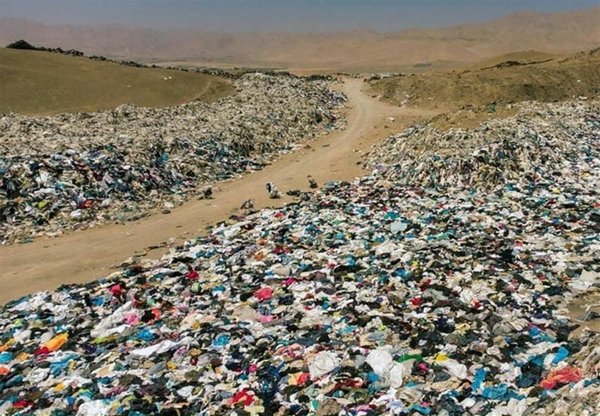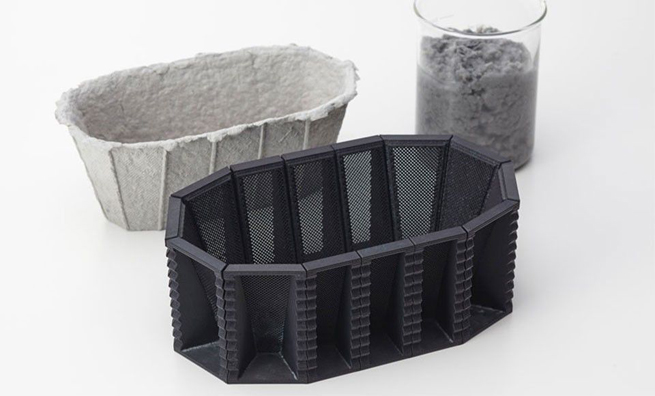The textile industry generates large amounts of wastes, especially in the steps involved in the clothing manufacturing process, which leads to large quantities of unwanted textile remnants (scraps and offcut).
Concerned about its environmental impact, a clothing manufacturing enterprise named atelier b, has chosen to undertake a zero-waste approach during the manufacturing process of their clothing. To achieve this, their challenge is to transform textile wastes into works of art, preventing textile remnants from ending up in landfill sites.
 Figure 1 : In Chile, tons of "fast fashion" clothing pile up in the Atacama Desert. Photo: AFP or licensors.
Figure 1 : In Chile, tons of "fast fashion" clothing pile up in the Atacama Desert. Photo: AFP or licensors.
The Textile Industry : A model that desperately needs re-inventing
Since ancient times, fabrics and fibers have always been a part of human activities. Fabrics are mainly used for clothing, but they also play a role in identifying social status and in responding to various fashions and trends. Once thriving, the textile industry in Québec has gradually been outsourced, leading to the disappearance of entire links in its value chain. As a result, local fiber production no longer exits; clothing manufacturing has almost completely been outsourced, finished products are largely imported, and there are few outlets for end-of-life textiles. This industry in Quebec suffers from a mainly linear organization, typically ending up by disposing these products in landfills. On a global scale, an estimated 50% of the products pertaining to the fashion industry are discarded within the same year of their production. As for the textile industry in Quebec, consumption of goods is substantial, while their recycling is inadequate. According to Recyc-Québec: "In Quebec, 3% of residual materials placed in household wastes or recyclable bins consist of textile or clothing products. This adds up to 12 kg of waste/person/year or a little over 95 000 tons of generated waste." At this moment, recycling options for textiles are almost inexistant: some clothing is transformed into rags, and some cutting remnants are defibered to produce felts, but practically none are available for post-consumer textiles.
Initiatives Taken to Halt this Prevailing Trend in the Fashion Industry
Anne-Marie Durand-Laflamme and Catherine Métivier are friends and founders of the brand atelier b, which began its operations in 2009. Their sustainable and minimalist clothing collections are designed in their workshop-boutique located in Montreal and are made from natural fiber textiles. Each year, the manufacturing of their clothing collections generates a ton of textile remnants. The two designers have chosen to give value to these scraps by developing a collection of utility art objects (Figure 1).
 Figure 2. Collection of design objects made from production scraps and end-of-life garments (https://atelier-b.ca)
Figure 2. Collection of design objects made from production scraps and end-of-life garments (https://atelier-b.ca)
Textile Remnants : From Wastes to Designer Objects
A remnant is a part of an object that is trimmed or cut during its manufacturing, such as fabric scraps and offcuts that remain after the clothing has been completed. The act of trimming and cutting allows for the transformation of an initial object into something new and refined. The idea of applying a circular economy to these remnants would be to make good use of the scraps and offcuts. In this specific case, the "upcycling" of these materials involves transforming fabric scraps and offcuts or unwanted garments into a collection of utility art objects with a higher added value. The challenges involved are numerous, and several processes of trial an error are involved to find the right techniques for drying, molding, or thermoforming the raw material into innovative art and decorative objects. Moreover, natural fibers are typically mixed with other components, in which cotton, linen, or lyocell (an artificial fiber made of chemically modified cellulose processed in a much more environmentally friendly way than rayon obtained through the viscose process) can be found. Thus, pulping or textile defibration by refining remains an important challenge for enhancing the value of remnants into a higher-added value material. The two businesswomen have already proposed an ingenuous artistic process for transforming textiles into cellulosic pulp. Subsequently, this pulp will be transformed into 3D objects through molding and thermoforming techniques (Figure 2).
 Figure 3. Prototypes of thermoformed pulp, made from scraps of linen and cotton fabrics.
Figure 3. Prototypes of thermoformed pulp, made from scraps of linen and cotton fabrics.
Research and innovation serving the design industry and the circular economy
In order to develop their product collections and gain more expertise in molded/thermoformed products, atelier b has turned to Innofibre for advice. This team of experts, which is part of the network of collegiate technology transfer centers (CCTT), is specialized in cellulosic fiber and is working to address the main technical challenges to accelerate the development of emerging high-value cellulosic packaging. Thermoformed products have seen significant technological development and a lot of industrial interest in recent years. These products are highly versatile and can be used not only for luxury goods but also as protective packaging for mass-market products. Thanks to improvements in this technology, the finished products are elegant and sophisticated. Molded fiber packaging has come a long way from the classic egg cartons, now offering luxury thermoformed packaging for high-end brands.
During its initial collaboration stage, atelier b and Innofibre studied the potential of integrating textile fibers from scraps as the main material in the production of pulp for the thermoforming process. To this day, the results lead towards great possiblities, and have led to the production of samples with a rich and silky finish.
While the production of thermoformed pulp is a quick and simple process, the mold-making process is typically tedious and requires a lot of design work. However, mold making is essential to achieve the desired shape and necessary characteristics. For many applications, 3D printing helps reduce design lead times and mold production costs (Figure 3).
 Figure 4. Formation mold made from a 3-D printing Designer, Kazuhiko Hayakawa. Source: http://experimental-creations.com/
Figure 4. Formation mold made from a 3-D printing Designer, Kazuhiko Hayakawa. Source: http://experimental-creations.com/
Thus, 3-D printing of molds provides a fast and cost-effective alternative for molding natural fibers. Owing to the expertise of Innofibre in molding/thermoforming products and the support of professors from the Cégep de Trois-Rivières in 3-D printing mold design, atelier b and Innofibre are currently developing sustainable and innovative solutions to transform fabric scraps and offcut into high-value-added utility art objects.
Conclusion:
The circular economy is an inevitable transition towards a production model that dissociates economic growth from resource consumption and reduces the environmental impacts of end-of-life consumer goods. By combining the innovative concepts developed by CCTTs and local entrepreneurs, Quebec is accelerating its transition towards a low-carbon emissions, prosperous, and resilient economy; the development of utility art objects is a perfect example.
Innofibre Mission
"Contribute to the technological positioning and sustainable development of the paper and biorefining industry, by supporting the innovation and diversification of products derived from biomass and by adapting papermaking technologies."
 Eric Denoes
Eric Denoes
Researcher at Innofibre














